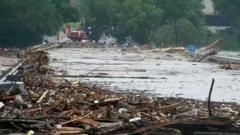What Caused the Deadly Flash Flooding in Central Texas?

Understanding the Impact of Flash Flooding in Central Texas
The recent flash flooding in central Texas has left communities reeling as disaster declarations have been issued across the Hill Country and Concho Valley regions. With several confirmed fatalities and many more individuals still unaccounted for, the situation is dire. As rescue operations unfold and warnings of additional flooding loom, it is crucial to understand the causes, effects, and necessary safety measures in such natural disasters. This article aims to provide a comprehensive overview of the event, the response efforts, and the potential implications for the region moving forward.
The Cause of Flash Flooding in Central Texas
Flash flooding typically occurs when heavy rainfall overwhelms the natural drainage systems in a short period, leading to rapid rises in water levels. In central Texas, the region’s unique topography, combined with recent weather patterns, has created the perfect storm for such an event. Key factors contributing to the flash flooding include:
- Geography: The Hill Country's rugged terrain can exacerbate flooding, as runoff quickly accumulates in low-lying areas.
- Soil Saturation: Previous rainfall in the days leading up to the flooding left the soil saturated, reducing its ability to absorb additional water.
- Weather Patterns: Seasonal thunderstorms in Texas can bring intense rainfall over a short period, leading to flash floods.
The Impact of the Flooding
The immediate impact of the flash flooding has been devastating. Communities in the affected areas, including Kerrville, Ingram, and Hunt, have experienced extensive property damage, disrupted infrastructure, and loss of life. Here are some of the critical effects observed:
Casualties and Missing Persons
As authorities work to assess the situation, the number of casualties and missing persons continues to fluctuate. While officials have confirmed fatalities, the exact number remains uncertain as search and rescue operations are ongoing. The emotional toll on families and communities grappling with loss and uncertainty cannot be overstated.
Property and Infrastructure Damage
The floodwaters have swamped homes, businesses, and critical infrastructure, including roads and bridges. Many neighborhoods have become inaccessible due to fast-moving water, prompting evacuations. The financial implications of such widespread damage can be staggering, affecting local economies and the livelihoods of residents.
Environmental Consequences
Flash flooding can have long-term effects on the environment, particularly in sensitive ecosystems. Soil erosion, contamination of water sources, and damage to wildlife habitats are some consequences that may arise in the aftermath of flooding. These environmental challenges can complicate recovery efforts and necessitate comprehensive restoration plans.
Emergency Response Efforts
In response to the catastrophic flooding event, state and local authorities have mobilized resources to assist affected communities. Here are some key aspects of the emergency response:
Rescue Operations
Emergency services have been working tirelessly to rescue individuals trapped in flooded areas. Boats and helicopters have been deployed to reach those stranded, reflecting the urgency and seriousness of the situation. Local law enforcement agencies, alongside state and federal responders, are coordinating efforts to ensure the safety of residents.
Evacuations and Shelters
Evacuations have been ordered in the most severely impacted areas. Temporary shelters have been established to provide refuge for displaced residents. Community organizations and volunteers are stepping up to offer support, including food, clothing, and other essential services.
Public Safety Warnings
Officials have issued strong warnings to the public regarding the ongoing risk of flooding. Residents are urged to stay alert, heed local emergency alerts, and avoid driving through flooded roads. The Texas Department of Agriculture has emphasized the importance of safety precautions, highlighting the unpredictability of floodwaters even during light rainfall.
Looking Ahead: Recovery and Preparedness
As recovery efforts begin, it is essential for communities to learn and adapt from this flooding event. Here are some critical steps that can be taken to enhance preparedness for future flooding:
Long-term Planning and Infrastructure Improvements
Investing in infrastructure improvements is vital for reducing the risk of future flooding. This may include:
- Upgrading drainage systems to handle heavy rainfall.
- Creating flood retention basins in vulnerable areas.
- Restoring natural landscapes that can absorb rainfall, such as wetlands and forests.
Community Education and Awareness
Educating residents about the risks of flash flooding and best practices for safety can significantly improve community resilience. Local authorities should consider implementing:
- Public workshops on emergency preparedness.
- Disseminating information on warning systems and evacuation routes.
- Engaging schools and community groups in disaster response training.
Emergency Response Planning
Communities must have a well-defined emergency response plan that includes:
- Clear communication protocols during emergencies.
- Designated roles for local agencies and volunteers in response efforts.
- Regular drills to practice evacuation and rescue procedures.
Conclusion
The flash flooding in central Texas serves as a sobering reminder of the power of nature and the importance of preparedness. As communities work toward recovery, it is crucial to assess the lessons learned and implement strategies to mitigate the impact of future flooding events. By enhancing infrastructure, educating residents, and preparing for emergencies, communities can build resilience against the unpredictable forces of nature.
In the wake of such devastation, it is essential to support one another and reflect on how we can be better prepared for future challenges. What steps can you take in your own community to promote awareness and safety regarding natural disasters? #FlashFlood #TexasFlooding #EmergencyPreparedness
FAQs
What should I do if I encounter flooded roads?
Do not attempt to drive through flooded roads. Turn around and find an alternative route. Always prioritize your safety and follow local emergency alerts.
How can communities prepare for future flash floods?
Communities can invest in infrastructure improvements, educate residents about flooding risks, and develop comprehensive emergency response plans to enhance preparedness.
What resources are available for those affected by flooding?
Local authorities typically provide shelters and assistance services. Community organizations may also offer food, clothing, and emotional support to those displaced by the flooding.
Published: 2025-07-04 18:11:11 | Category: technology



